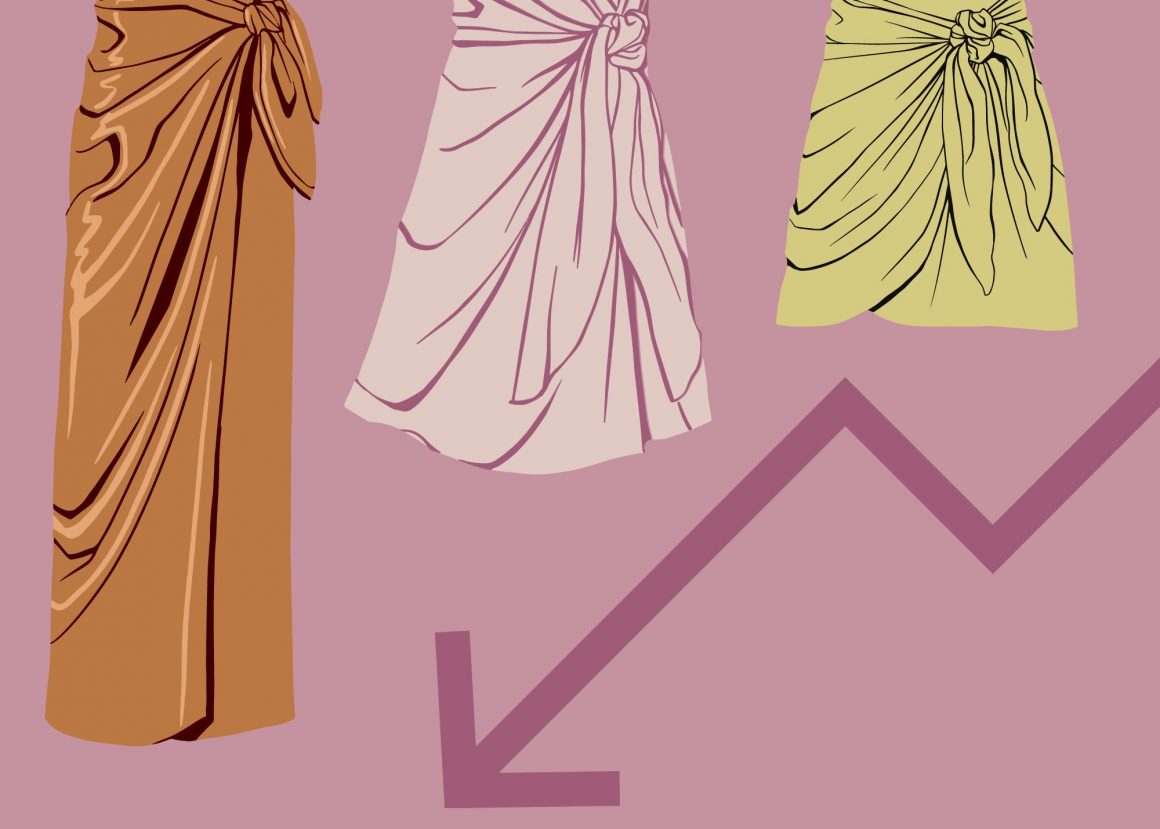
The Hemline Index: How fashion reflects economic trends
By Nazeefa Ahmed, October 31 2022—
Longer skirts are a staple in many wardrobes this season. Looking around campus, you will see many people choosing to wear the piece over other modern bottoms, such as skinny jeans and mini skirts. When considering pants, feminine fashion has also opted for a baggier silhouette that either drapes on or over the shoes, creating a longer and more romantic edge to outfits.
In fact, this trend is not limited to the university alone. Longer skirts have been making a comeback all year. Celebrities and influencers such as Kendall Jenner and Priyanka Chopra have been rocking longer skirts, pairing the item artfully with their usual attire. The long skirt also had a moment when Emma Chamberlain wore a floor-grazing silhouette to the May 2022 Met Gala.
The rise of longer hemlines and draping fabrics signals a return to Y2K fashion: a time when Paris Hilton would grace magazine covers and Kim Kardashian was just her plus one. Y2K fashion spanned from the late 90s to the early 2010s and is characterized by its bold colours, statement accessories, and experimental layering of pieces.
However, unlike the extravagant patterns and fabrics of the 2000’s, today’s expressions of Y2K fashion, particularly the long skirt, have muted colours and patterns — they seem to be a combination of 90s minimalism and Y2K flare. This season’s silhouettes and colours, while drawing inspiration from decades past, have real implications in the present, namely through the Hemline Index.
The Hemline Index was first recognized in 1926 by Wharton Business School professor George Taylor. His theory predicted that when the economy was prospering, women’s hemlines would rise. Similarly, when a recession is underway, they will fall again. Taylor’s predictions were made during the 1920 economic boom, a time when shorter flapper dresses were popular. Fashion during that decade focused on extravagance and maximalism. Once the Great Depression hit, however, hemlines dropped to more conservative lengths again; earthier and muted colours were the norm to reflect the somber mood of the era.
This trend continues across the decades. The war-time boom of the 40s saw rising hemlines as knee-length skirts were popularized but the length dropped once again right before the recession of 1949. The same trend is observed with miniskirts in the 60s and midi lengths before the 1987 stock market crash.
This begs the question: does the prevalence of longer skirts in 2022 mean that a recession is just around the corner? After all, numerous financial think-tanks have pointed to signs of an impending recession. The skyrocketing inflation, the war in Ukraine, and stagnant wages are all pulsing warnings. Economists at the World Economic Forum released a grave statement recently about the economic state we find ourselves in.
“We are in uncharted waters in the months ahead. The immediate outlook for the global economy and for much of the world’s population is dark,” read the statement.
All of this gloom and doom is making waves within the collective consciousness of society. We are keenly aware that our financial markets are on the precipice of something big. We are all holding our breath for the final verdict.
Therefore, it is not so much that longer hemlines signal economic downturn, rather, longer hemlines signal society’s reaction to bad news. We require security, a sense of comfort, and find this with looser, more conservative styles. For many women, skirts are also a way they can reclaim their femininity after wearing sweats and workout clothes for most of the pandemic.
On the contrary, the speed of trends and cuts and silhouettes falling in and out of style has caused some not to consider trends at all. Now, it has become common to build an aesthetic that represents one’s authentic self. Aesthetics, rather than trends, represent a lifestyle we would like to emulate. Aesthetics can be a creative outlet to escape a somber reality.
But even aesthetics are a product of our collective consciousness. During the pandemic, for example, homely and nature-oriented aesthetics became popular. You would often see reels of girls running through a field, or romanticizing farm life through “CottageCore” and “Coastal Grandmother” aesthetics. The trends reflected the collective need to pause and reconsider the fast paced lifestyle and materialistic values we have had up until then. Our fashion choices right after the pandemic reflect this as well, as people wore green, fuchsia and orange to bring life to their outfits after months of sweats and pajamas.
Clothing is a form of expression, one that we emulate more from each other than from out-of-reach runway shows. In 2021, we were relishing a return to normal life. In 2022, however, we sense economic insecurity from the media, our news outlets, and our friends. Naturally, our fabrics, silhouettes, and colour choices this season reflect this reality.
